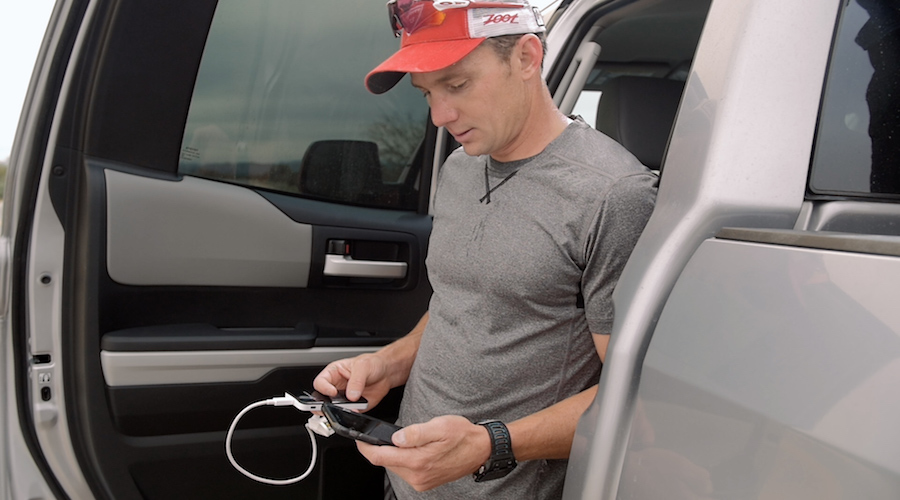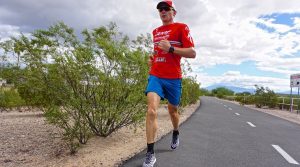The list of essential training information for endurance athletes has expanded to hemoglobin levels, which Ironman champ Ben Hoffman tracks “virtually every day.”
Writer: Carly Terwilliger
A day of training for Ironman champion Ben Hoffman begins with an hour-long 4,000-meter swim – and escalates from there. To break it down, Hoffman explained that in a typical week his total training time adds up to 35-42 hours, for 10-12 weeks leading into the event.
In other words, it’s a full-time job, and like most other jobs, technology has become an increasingly important component of Hoffman’s work day. “As a rule, endurance athletes are pretty tech savvy, and having the information is always better than not having it,” he told SGB. And increasingly, the list of essential information includes hemoglobin levels, which Hoffman tracks “virtually every day.”
Cercacor, which sponsors Hoffman as well as professional track and field champion Brenda Martinez, provides biomarker monitoring through its Ember device, which measures pulse rate, perfusion index, oxygen saturation, oxygen content, respiration rate, pleth variability index and hemoglobin level.
Here’s a quick science lesson for those aspiring to the heights reached by Hoffman, who recently retained the Ironman African Championship title and set a course record with a performance under eight hours (7:58:40). Hemoglobin (Hgb) is the protein contained in red blood cells that is responsible for delivery of oxygen to the tissues. The range of hemoglobin values can vary based on your age and biological sex. For adults 18 years and over at rest, hemoglobin values can be between 12-15.5 g/dl for females and 13-17.2 g/dl for males. Gains in hemoglobin may enable you to carry more oxygen in your body and have greater endurance.
Exercise and training regimens can have a substantial impact on hemoglobin. In general, exercise alters hemoglobin in two ways – acute and chronic changes in the plasma (water component of blood), and the actual change in the amount of hemoglobin present. These changes can be seen in the short term (minutes to hours) or long term (days to weeks).
Got it?
To further expound on how the biomarker works, Cercacor VP of Marketing Mel Chiba explained that “if the athlete sees his/her next, first-of-day hemoglobin value dip after a grueling training block, this may signal that the body has not fully recovered.”
Managing recovery is one of the biggest challenges of training at altitude, according to Hoffman. “It’s much harder to hit the high intensity sessions, and then to recover from them generally takes more time.” The Ironman champ embraces these challenges. “I have always found endurance training at altitude beneficial,” he said, adding that “by keeping an eye on my hemoglobin, oxygen saturation and other biomarkers, I’m able to tell how my body is responding to the altitude stressors, and when to push or hold back in training.”
It may seem like micromanagement – in addition to his Ember Hoffman uses “a variety of tools, including a bike power meter [and] GPS watch with heart rate.” But the reality is that successfully training for an endurance competition is hard enough without the added challenge of blindly guessing at how the body is responding to stress. In the case of non-professional athletes, said Chiba, “they don’t typically have access to coaches and/or trainers, so having a device like Ember that can provide feedback on how they respond to training can be a great asset.”
And even for pros like Hoffman, the structured feedback promotes focus and effectiveness. “By taking consistent measurements at first of day, end of day, and after many important training sessions, I have formed a strong baseline for where I need to be day-to-day to handle the training load,” he said. “It helped keep me on track by showing me trends in my hemoglobin and other biomarkers so I didn’t overreach or hold back too much during key sessions in the training block.”
Beyond the realm of endurance, Chiba sees opportunities for hemoglobin tracking to expand into other types of sports as well. “We see Ember being of great value to trainers and athletes with a variety of professional sports teams such as soccer, and potentially basketball and football,” he said. “We have also received interest from serious mountain climbers, as Ember is very useful in helping them understand how they are acclimating to various altitudes.”
Photos courtesy Ben Hoffman and Cercacor















